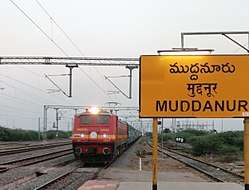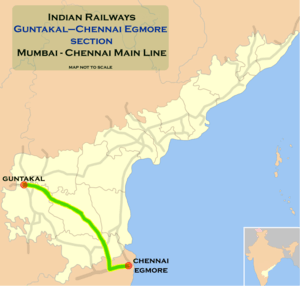Guntakal–Renigunta section
| Guntakal–Renigunta section | |||
|---|---|---|---|
 The prestigious Chennai Mumbai Mail runs along this section. | |||
| Overview | |||
| Status | Operational | ||
| Locale | Andhra Pradesh | ||
| Termini |
Guntakal Junction Renigunta Junction | ||
| Operation | |||
| Owner | Indian Railway | ||
| Operator(s) | South Central Railway | ||
| Technical | |||
| Line length | 144.30 km (89.66 mi) | ||
| Track gauge | 1,676 mm (5 ft 6 in) Broad gauge | ||
| |||
Guntakal–Renigunta section connects Guntakal and Renigunta in the Indian state of Andhra Pradesh. It is administered under Guntakal railway division of South Central Railway zone. It has a total route length of 309.50 km (192.31 mi).[1][2]
| Guntakal–Renigunta section | |||||||||||||||||||||||||||||||||||||||||||||||||||||||||||||||||||||||||||||||||||||||||||||||||||||||||||||||||||||||||||||||||||||||||||||||||||||||||||||||||||||||||||||||||||||||||||||||||||||||||||||||||||||||||||||||||||||||||||||||||||||||||||||||||||||||||||||||||||||||||||||||||||||||||||||||||||||||||||||||||||||||||||||||||||||||||||||||||||||||||||||||||||||||||||||||||||||||||||||||||||||||||||||||||||||||||||||||||||||||||||||||||||||||||||||||||||||||||||||||||||||||||||||||||||||||||||||||||||||||||||||||||||||||||||||||||||||||||||||||||||||||||||||||||||||||||||||||||||||||||||||||||||||||||||||||||||||||||||||||||||||||||||||||||||||||||||||||||||||||||||||||||||||||||||||||||||||||||||
|---|---|---|---|---|---|---|---|---|---|---|---|---|---|---|---|---|---|---|---|---|---|---|---|---|---|---|---|---|---|---|---|---|---|---|---|---|---|---|---|---|---|---|---|---|---|---|---|---|---|---|---|---|---|---|---|---|---|---|---|---|---|---|---|---|---|---|---|---|---|---|---|---|---|---|---|---|---|---|---|---|---|---|---|---|---|---|---|---|---|---|---|---|---|---|---|---|---|---|---|---|---|---|---|---|---|---|---|---|---|---|---|---|---|---|---|---|---|---|---|---|---|---|---|---|---|---|---|---|---|---|---|---|---|---|---|---|---|---|---|---|---|---|---|---|---|---|---|---|---|---|---|---|---|---|---|---|---|---|---|---|---|---|---|---|---|---|---|---|---|---|---|---|---|---|---|---|---|---|---|---|---|---|---|---|---|---|---|---|---|---|---|---|---|---|---|---|---|---|---|---|---|---|---|---|---|---|---|---|---|---|---|---|---|---|---|---|---|---|---|---|---|---|---|---|---|---|---|---|---|---|---|---|---|---|---|---|---|---|---|---|---|---|---|---|---|---|---|---|---|---|---|---|---|---|---|---|---|---|---|---|---|---|---|---|---|---|---|---|---|---|---|---|---|---|---|---|---|---|---|---|---|---|---|---|---|---|---|---|---|---|---|---|---|---|---|---|---|---|---|---|---|---|---|---|---|---|---|---|---|---|---|---|---|---|---|---|---|---|---|---|---|---|---|---|---|---|---|---|---|---|---|---|---|---|---|---|---|---|---|---|---|---|---|---|---|---|---|---|---|---|---|---|---|---|---|---|---|---|---|---|---|---|---|---|---|---|---|---|---|---|---|---|---|---|---|---|---|---|---|---|---|---|---|---|---|---|---|---|---|---|---|---|---|---|---|---|---|---|---|---|---|---|---|---|---|---|---|---|---|---|---|---|---|---|---|---|---|---|---|---|---|---|---|---|---|---|---|---|---|---|---|---|---|---|---|---|---|---|---|---|---|---|---|---|---|---|---|---|---|---|---|---|---|---|---|---|---|---|---|---|---|---|---|---|---|---|---|---|---|---|---|---|---|---|---|---|---|---|---|---|---|---|---|---|---|---|---|---|---|---|---|---|---|---|---|---|---|---|---|---|---|---|---|---|---|---|---|---|---|---|---|---|---|---|---|---|---|---|---|---|---|---|---|---|---|---|---|---|---|---|---|---|---|---|---|---|---|---|---|---|---|---|---|---|---|---|---|---|---|---|---|---|---|---|---|---|---|---|---|---|---|---|---|---|---|---|---|---|---|---|---|---|---|---|---|---|---|---|---|---|---|---|---|---|---|---|---|---|---|---|---|---|---|---|---|---|---|---|---|---|---|---|---|---|---|---|---|---|---|---|---|---|---|---|---|---|---|---|---|---|---|---|---|---|---|---|---|---|---|---|---|---|---|---|---|---|---|---|---|---|---|---|---|---|---|---|---|---|---|---|---|---|---|---|---|---|---|---|---|---|---|---|---|---|---|---|---|---|---|---|---|---|---|---|---|---|---|---|---|---|---|---|---|---|---|---|---|---|---|---|---|---|---|---|---|---|---|---|---|---|---|---|---|---|---|---|---|---|---|---|---|---|---|---|---|
| |||||||||||||||||||||||||||||||||||||||||||||||||||||||||||||||||||||||||||||||||||||||||||||||||||||||||||||||||||||||||||||||||||||||||||||||||||||||||||||||||||||||||||||||||||||||||||||||||||||||||||||||||||||||||||||||||||||||||||||||||||||||||||||||||||||||||||||||||||||||||||||||||||||||||||||||||||||||||||||||||||||||||||||||||||||||||||||||||||||||||||||||||||||||||||||||||||||||||||||||||||||||||||||||||||||||||||||||||||||||||||||||||||||||||||||||||||||||||||||||||||||||||||||||||||||||||||||||||||||||||||||||||||||||||||||||||||||||||||||||||||||||||||||||||||||||||||||||||||||||||||||||||||||||||||||||||||||||||||||||||||||||||||||||||||||||||||||||||||||||||||||||||||||||||||||||||||||||||||
|
Sources:[3] | |||||||||||||||||||||||||||||||||||||||||||||||||||||||||||||||||||||||||||||||||||||||||||||||||||||||||||||||||||||||||||||||||||||||||||||||||||||||||||||||||||||||||||||||||||||||||||||||||||||||||||||||||||||||||||||||||||||||||||||||||||||||||||||||||||||||||||||||||||||||||||||||||||||||||||||||||||||||||||||||||||||||||||||||||||||||||||||||||||||||||||||||||||||||||||||||||||||||||||||||||||||||||||||||||||||||||||||||||||||||||||||||||||||||||||||||||||||||||||||||||||||||||||||||||||||||||||||||||||||||||||||||||||||||||||||||||||||||||||||||||||||||||||||||||||||||||||||||||||||||||||||||||||||||||||||||||||||||||||||||||||||||||||||||||||||||||||||||||||||||||||||||||||||||||||||||||||||||||||
History
The first train service in southern India and the third in India was operated by Madras Railway from Royapuram / Veyasarapady to Wallajah Road (Arcot) in 1856. Madras Railway extended its trunk route to Beypur / Kadalundi (near Calicut) and initiated work on a north-western branch out of Arakkonam in 1861. The branch line reached Renigunta in 1862.[4] The branch line out of Arakkonam reached Raichur in 1871, where it connected to the Great Indian Peninsula Railway line from Mumbai.[5]
Railway reorganization
In the early 1950s legislation was passed authorizing the central government to take over independent railway systems that were there. On 14 April 1951 the Madras and Southern Mahratta Railway, the South Indian Railway Company and Mysore State Railway were merged to form Southern Railway. Subsequently, Nizam's Guaranteed State Railway was also merged into Southern Railway. On 2 October 1966, the Secunderabad, Solapur, Hubli and Vijayawada Divisions, covering the former territories of Nizam’s Guaranteed State Railway and certain portions of Madras and Southern Mahratta Railway were separated from Southern Railway to form the South Central Railway. In 1977, Guntakal division of Southern Railway was transferred to South Central Railway and the Solapur division transferred to Central Railway. Amongst the seven new zones created in 2003 was South Western Railway, which was carved out of Southern Railway.[6]
Electrification
Electrification of the 308 km long Renigunta-Guntakal section was announced in 2003 at a cost of Rs. 168 crore. The Renigunta-Nandalur sector electrification was completed in 2006.[7][8] The Nandalur-Guntakal sector was electrified by 2013.[9]
Connectivity
Obulavaripalli in this line connects the newly constructing Krishnapatnam–Obulavaripalle railway lane
Speed limit
As of 2012, doubling of the Renigunta-Guntakal section was expected to be completed soon. [10]
Sheds and Workshops
Guntakal diesel loco shed was started as a metre gauge shed but after gauge conversions in Guntakal and Hubli divisions a broad gauge shed was opened in 1995. It houses WDM-2, WDM-3A, WDM-3D and WDG-3A locos. There is a routine overhaul depot for wagon maintenance at Raichur and a coaching maintenance depot at Guntakal.[11]
Diesel loco shed,Gooty has one of the largest sheds with 175+ locos that include WDG-3A, WDM-3A, WDM-3D, WDG-4, WDP-4 diesel locos. It also handles routine maintenance for WDG-4 locos. It earlier used to be broad gauge steam loco shed.[11] Renigunta has an electric trip shed.[11]
References
- ↑ "Section Wise Route (kms)". South Central Railway. Retrieved 2 June 2017.
- ↑ "Guntakal Railway Division System Map". South Central Railway. Retrieved 2 June 2017.
- ↑ "Mumbai Dadar-Chennai Egmore Superfast Express 12163". India Rail Info.
- ↑ "IR History – Early days". 1832–1869. IRFCA. Retrieved 14 December 2013.
- ↑ "IR History:Early days II". 1870–1899. IRFCA. Retrieved 14 December 2013.
- ↑ "Geography – Railway Zones". IRFCA. Retrieved 14 December 2013.
- ↑ "Reenigunta-Guntakal Railway Electrification Project". Progress Register. Retrieved 14 December 2013.
- ↑ "Rail Projects in Andhra Pradesh". Press Information Bureau, 21 November 2006. Retrieved 14 December 2013.
- ↑ "Brief on Railway Electrification". Electrification Work in Progress. Central Organisation for Railway Electrification. Retrieved 14 December 2013.
- ↑ "Kadapa-Bangalore railway line in 7 years". The Hindu, 13 March 2012. Retrieved 14 December 2013.
- 1 2 3 "Sheds and Workshops". IRFCA. Retrieved 14 December 2013.
